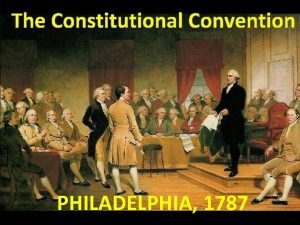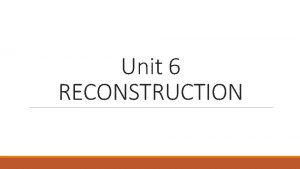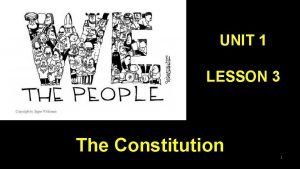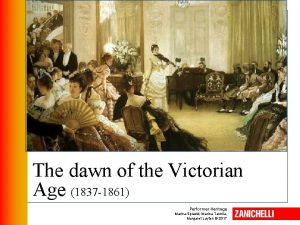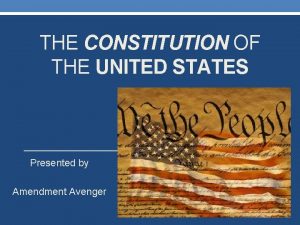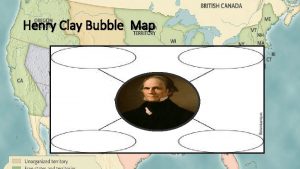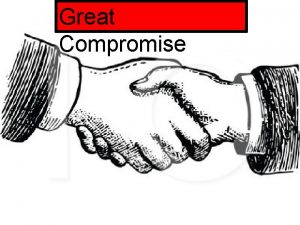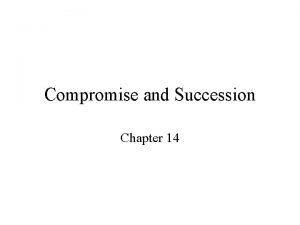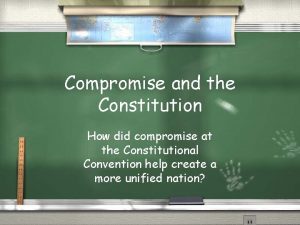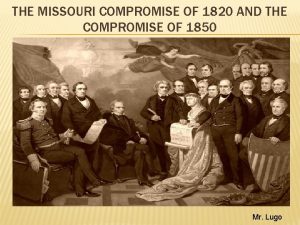Convention and Compromise Chapter 7 Lesson 2 Convention










- Slides: 10

Convention and Compromise Chapter 7, Lesson 2

Convention and Compromise ► After the Revolution the country suffered from a depression (a period when economic activity slowed and unemployment increases) § Southern Plantation were ruined and rice exports dropped sharply. § Trade slowed when the British cut off access to the West Indies. ► Farmers had a difficult time paying the requests for money to pay off the Revolutionary debt. § This resulted in farmers having their farms seized by the state, and many went to jail. ► Shay’s Rebellion (1786) – Daniel Shay leads a group of farmers to shut down courts so judges could not confiscate their lands. § He led more than 1, 000 farmers to a federal arsenal om Springfield, Massachusetts to gather guns and ammo. § This rebellion frightened Americans and worried that government could not control unrest and violence.

Convention and Compromise ► Slavery – Many Americans after the revolution realized the contradiction between the fight for liberty and the practice of Slavery. § Between 1776 and 1786 11 states (except for S. Carolina and Georgia) outlawed or heavily tax the importation of slaves (high taxes might discourage people from buying/selling slaves) § Despite some African Americans being freed, they faced discrimination and were not allowed to vote, prevented from being in public places, and children going to separate schools. § The South had built their economy on slavery and feared it would not survive without it. § Manumission – the freeing of individual enslaved persons.

Convention and Compromise ► James Madison (Virginia) and Alexander Hamilton (New York) wanted to see changes to the Articles. § Hamilton proposes calling a convention in Philadelphia to discuss issues. § Washington was uneasy at first, but the events of Shay’s Rebellion change his mind and with his attendance, the meeting took on greater importance. ► Constitutional Convention (Philadelphia Convention) (1787) – Convention held to discuss necessary changes. § Washington was chosen to preside over the meetings. § All states have one vote on all questions with only a simple majority of the states present with at least 7 states being represented. § Delegates decided to close doors and keep the sessions secret in order to speak freely.

Convention and Compromise ► The Virginia Plan – introduced by Edmund Randolph of Virginia. § Largely the work of James Madison. § Two-House Legislature, a chief executive chosen by the legislature, and court system. § Members of the lower house would choose the members of the upper house. § Number of Representatives would be proportional (corresponding in size) to the population of a state § Small states such as Delaware, New Jersey immediately objected saying that the states were not represented equally.

Convention and Compromise ► The New Jersey Plan – introduced by William Patterson of New Jersey as an alternative plan to the revision of the Articles of Confederation. § One-House Legislature, with one vote for each state § Congress would be allowed to set taxes and regulate trade (Previously not given in the Articles) § Congress would elect a weak executive branch consisting of more than one person. § Patterson argued that the Convention should not deprive smaller states and his plan was designed to simply amend the Articles of Confederation.

Convention and Compromise Delegates needed to decide on weather to simply change the Articles or write a totally new constitution. ► The states voted to work on a national government based on the Virginia Plan, but needed to resolve the issue of representation. ► Some disagreements occurred on the topic of how to elect Congress, how to determine the upper and lower house, and were enslaved people counted towards the population. ► The Great Compromise – suggested by Roger Sherman of Connecticut. ► § Compromise – agreement between two or more sides in which each side gives up some of what they want. § He proposes a two-house legislature with the lower house being the House of Representatives (Based on the state’s population) and the upper house being the Senate (Each state receives two members in this house)

Convention and Compromise ► The Three-Fifths Compromise – Compromise stating that enslaved persons would count as three-fifths of a free person. § The South wanted to count slaves in order to get more delegates in the House of Reps while the North was opposed because enslaved people were considered property and should only be counted for taxing purposes, not representation. § The compromise made it so that every 5 slaves counted as 3 freed persons. ► Slave Trade was another touchy subject and the North agreed not tot ouch this topic in Congress until 1808. § Mostly to keep the South on board with the changes being made.

Convention and Compromise ► Bill of Rights – George Mason of Virginia proposed this as a safeguard that the government would not abuse its power. § Some people believed this new constitution was carefully worded enough that this should not be an issue. § This proposal is initially (at first) defeated. ► The Constitution was signed on September 17, 1787. § Delegates assembled in the Philadelphia state house to sign it. § Elbridge Gerry (Massachusetts), Edmund Randolph (Virginia), and George Mason (Virginia) refused to sign without a Bill of rights. § The Delegates agreed that to pass the Constitution a total of 9 of 13 states had to approve

 Constitutional convention compromise
Constitutional convention compromise Va plan nj plan great compromise
Va plan nj plan great compromise Manifest destiny was used to justify an american desire to
Manifest destiny was used to justify an american desire to Lesson 1 - the constitutional convention
Lesson 1 - the constitutional convention What was the goal of reconstruction
What was the goal of reconstruction 3/5 compromise
3/5 compromise The dawn of victorian age zanichelli
The dawn of victorian age zanichelli Ex post facto law
Ex post facto law What is respiratory compromise
What is respiratory compromise Explain the compromise of 1850
Explain the compromise of 1850 The great compromise chart
The great compromise chart
